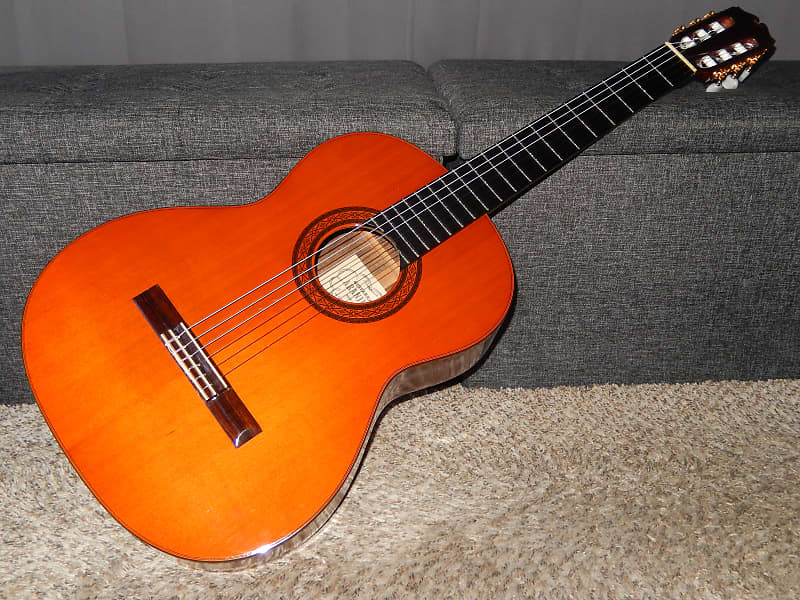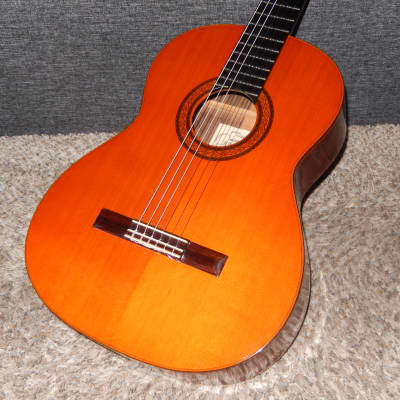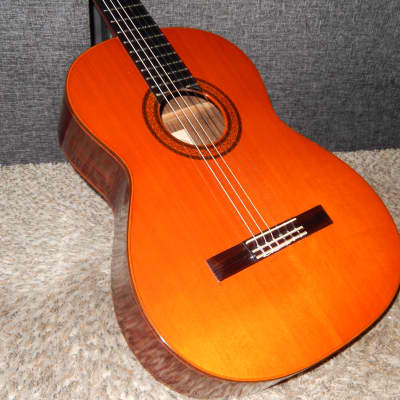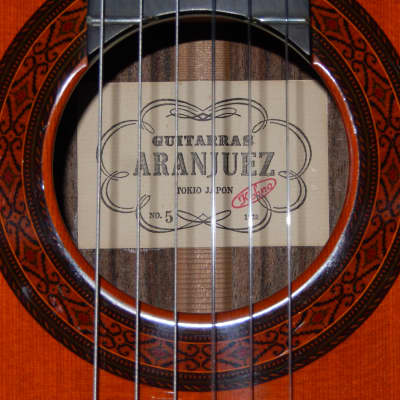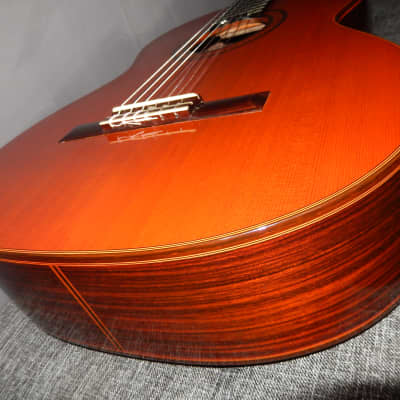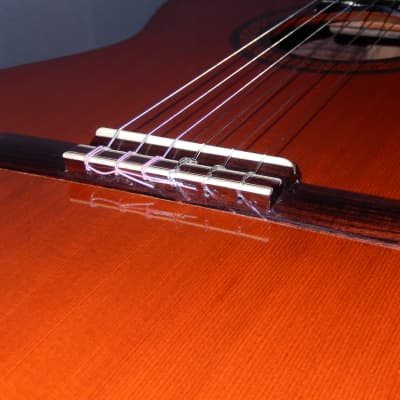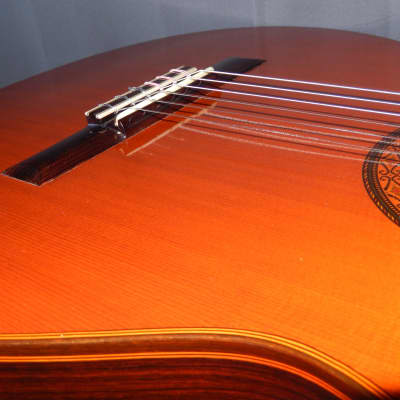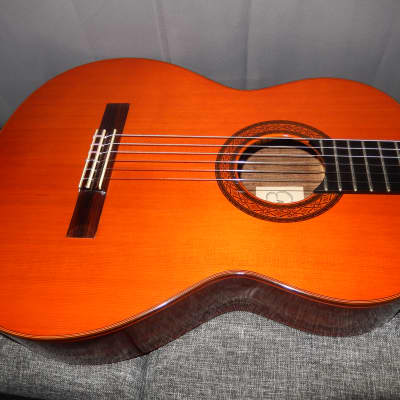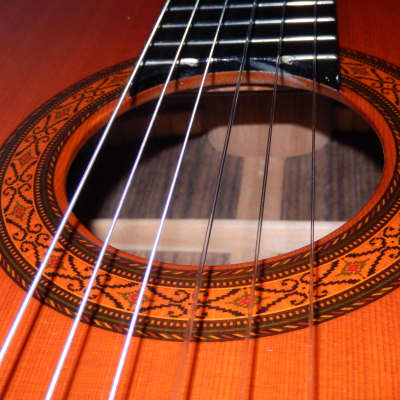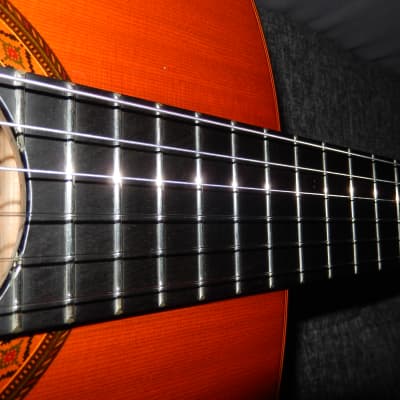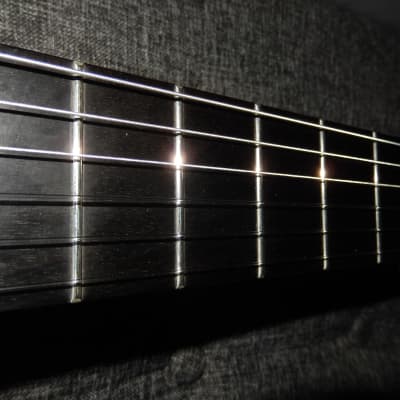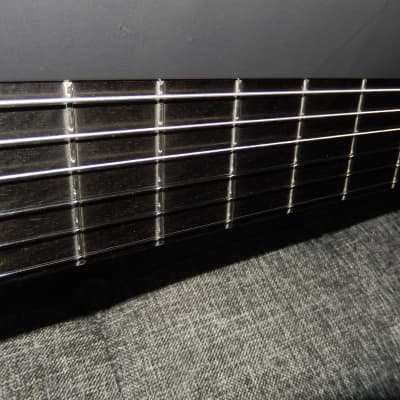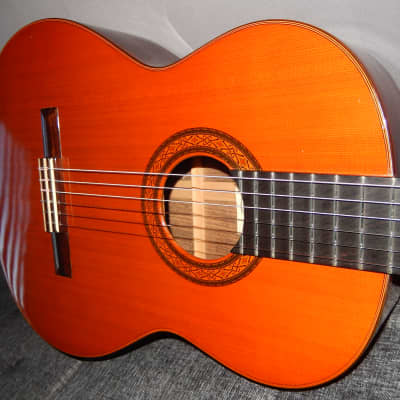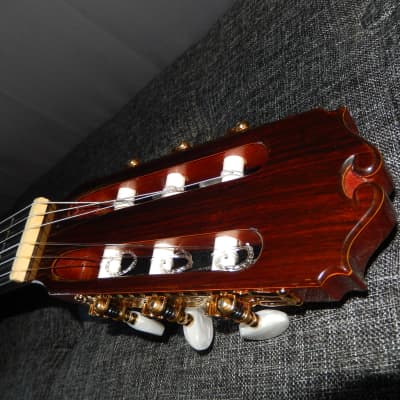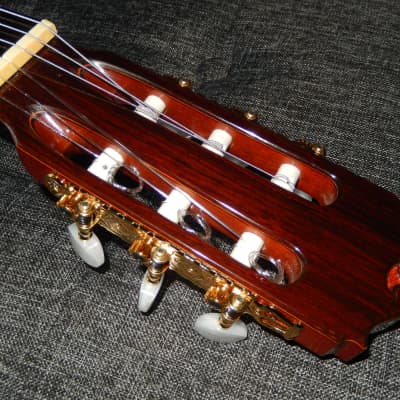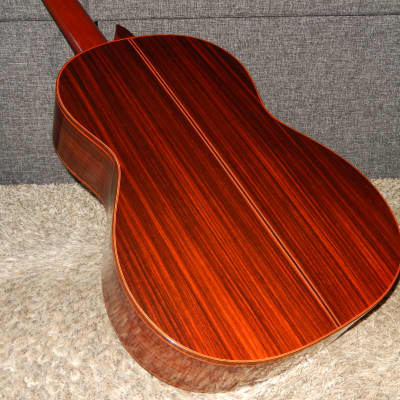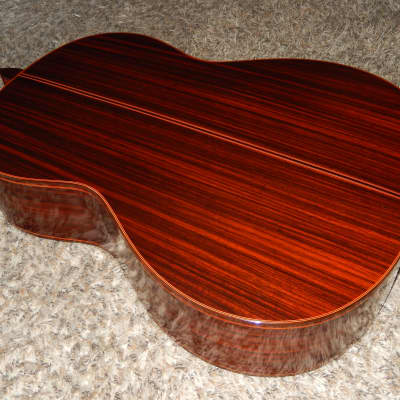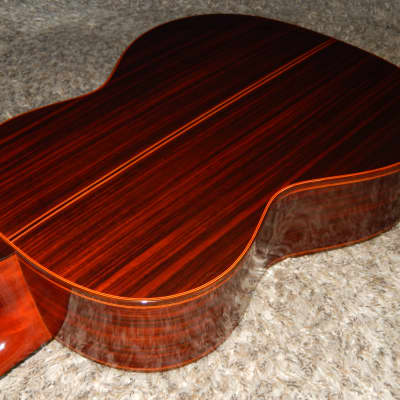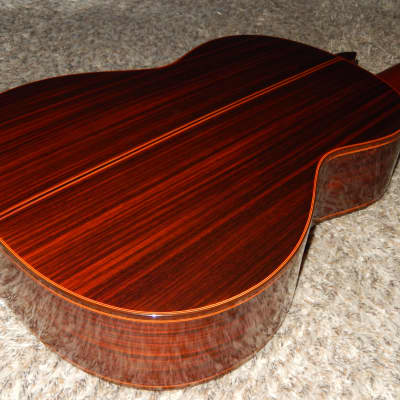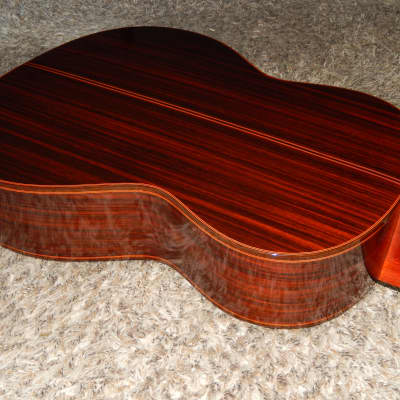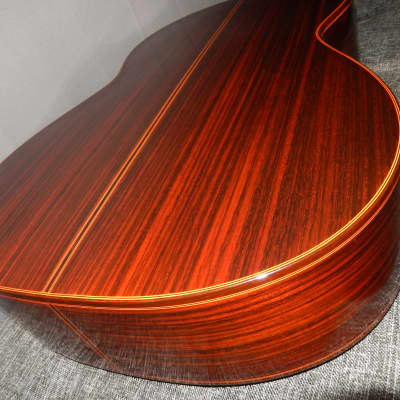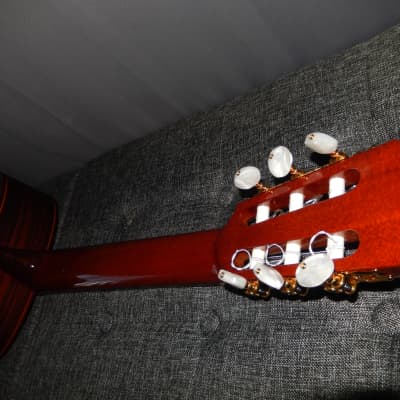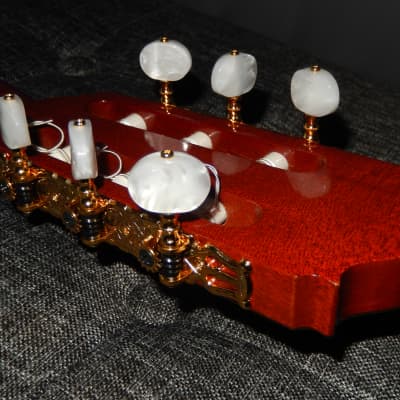Several hundred guitars I have sold in the past are presented at Facebook.com/Victors.Guitar.Library.
ARANJUEZ No5 1972
This guitar was made in 1972 by Takamine workshop under the supervision of Masaru Kohno workshop.
Aranjuez guitars line was founded by Masaru Kohno in 1968 (soon after he took over Takamine and delegated his pupil Mass Hirade to manage the company). At first these guitars were named Yamato and had identical design label as you can see on this guitar. Aranjuez guitars were designed exclusively for Japanese market. They were made by Takamine workshop under Masaru Kohno’s supervision until 1977. In 1978-1979 they were still made by Takamine however Kohno stamp was absent on their labels. In 1979 Takamine discontinued their Ramirez style Elite line and started making models with identical design and construction as Aranjuez brand, while Aranjuez line was discontinued for at least few years. The Aranjuez brand was resurrected in the late 1980s and made by Ryoji Matsuoka workshop. Their headstock was like on Mathias Dammann guitars. After the closure of Matsuoka’s workshop (2014) Aranjuez guitars are again made by Takamine co. under Masaki Sakurai’s supervision.
The secret of Aranjuez guitars is that they have always offered exceptional value to the player on a budget. Top Aranjuez models sounded better than many guitars sold by leading Japanese makers at 2 times higher prices.
Since the origin of this brand the very top models were assembled and finished at Kohno’s workshop. The bodies of those top models were made by Takamine or Matsuoka workshops, while soundboards were made by either Masaru Kohno himself or one of his associates, perhaps by Masaki Sakurai. Currently the very top Aranjuez model 725 is still being assembled and finished personally by Masaki Sakurai and is priced 275 000 yen, while it sounds better than many other guitars sold in Japan 350 000 yen.
This Aranjuez No5 guitar was priced 50 000 yen in 1972 yen while it sounds on pair with many guitars from that era priced 100 000 yen.
From the early through late 1970s the top of Aranjuez line was model 7 assembled at Masaru Kohno workshop. The second from the top was model No6. Both models 6 & 7 were “all solid woods” construction. Although I have never seen or heard about one, I am confident that both models were already made in 1972. Therefore model 5 certainly wasn’t the top of the line even though its headstock closely resembles headstock used by Masaru Kohno on his top of the line models. I have sold several and seen hundreds of Aranjuez guitars yet never before seen one with such a headstock.
What is also very important to mention is that while all Aranjuez models of 1970s had Cedar tops, all Kohno models had Spruce tops. Regardless of what some sellers believe and claim in their listings, Masaru Kohno wasn’t making Cedar top guitars until 1985. Those Kohno’s Cedar top models were made in very limited numbers (perhaps by special order only), their soundboards look very dark, rosettes and bridge decoration are different from those used on regular Spruce top models.
This truly majestic guitar offers exceptional volume and response combined with very romantic tonality. Its trebles are super sweet, round, yet very crisp. Basses are deep and full of overtones, yet relatively clean. All notes are well balanced, note clarity and separation fantastic, sustain amazing.
I am sure that every experienced player will agree that this guitar beats many “hand made in Spain” $5000+ guitars available on US market. Takamine C132S currently sold for $1950USD sounds like a “child’s toy” if compared to this Aranjuez 5 1972 guitar.
This guitar remains in practically mint condition, without any sign of use. Only with a magnifying glass or falcon’s eye one can find a mark on its body. Original tuners also looked like new but were hard to turn and were replaced by brand new Gotoh set.
Specifications:
Top: High Grade Solid Cedar/cashew lacquer
Back and Sides: Non-Solid Latin America Rosewood /cashew lacquer
Neck: Mahogany
Fingerboard: Ebony
Tuning Machines: high grade gold plated
Scale: 660 mm
Nut Width: 52 mm
Nut & Saddle: Bone
Strings: Savarez Cristal Normal Tension
Current action is set to 3.80 mm under E6 and 3.20 under E1 with still extra room on the saddle (about 3.00mm on the E6 side and 2.00mm on the E1 side).
It will be shipped in a used original hard-shell case that is fully functional but with serious deterioration on the outside. This case is free.
Real Value of Japanese Vintage Guitars
The key to understand value of vintage Japanese guitars is to acknowledge galloping price inflation (devaluation of Japanese yen) during 1960s & 1970s. This inflation slowed down in the 1980s.
During 1960s and most of 1970s model numbers of Japanese guitars were strictly interconnected with their prices in Japanese yen. By early 1980s and during following decades model numbers were no longer strictly associated with their prices. Some Japanese guitar makers introduced model names instead of model numbers. Others were still using model numbers with the addition of letters and/or other symbols.
It is then important to understand that two Yamaha GC10 guitars made 10 years apart are two instruments of totally different class. The same applies to any other Japanese maker/brand.
The logical way to estimate the true class of any given Japanese made instrument is to compare its price with the average annual salary of wage workers in Japanese private sectors. This salary was: 450 600 yen in 1965 - 825 900 yen in 1970 - 1 868 300 yen in 1975 - 2 689 000 yen in 1980 - 3 163 000 yen in 1985 - 3 761 000 yen in 1990 - 4 107 000 yen in 1995 - 4 082 000 yen in 2000.
Any guitar priced 100 000 yen in 1970 (labelled as No10 or No100) would be priced 200 000 yen in 1975 (relabeled to No20, No200 or 2000), 300 000 yen in 1977 (labelled as No3, No30 or 3000) and 500 000 yen by 1985 (labelled as No50 or 5000).
Starting in 1977 Masaru Kohno introduced his new models No40 priced 400 000 yen and No50 priced 500 000 yen. By the early 1980s Kohno started using model names instead of numbers and was steadily raising their prices without changing model labeling. His very top model 50 became model “Special”, and a decade later it became model “Maestro”. Naturally, all other Japanese guitar makers were doing similar pricing (labelling) upgrades.
Knowing all of that, you can bet on that Masaru Kohno No50 made in 1982 is practically the same grade instrument as Kohno No20 made in 1972, or Kohno no 30 made in 1975.
In the early 1970s the lowest Ryoji Matsuoka (all plywood) model was 10, followed by (solid top) models 15, 20, 25, 30, 40, 50, 60, 80 and (all solid woods) models 100 and 150. Models 50, 60 and 80 were made with non-solid figured Brazilian Rosewood (double) back and sides and top model 150 was the only one made with solid figured Brazilian Rosewood b/s.
In 1980 the lowest Matsuoka model was (all plywood) 20, followed by (solid top) models 30,40,50, 60 and all solid woods models 80,100,150 and 200. By 1990 the lowest Matsuoka model was M40 and the highest was M300. By 2010 the lowest Matsuoka model was M50, and the top model was M270.
You can bet that Ryoji Matsuoka model 50 from 1980 is of the same grade as model M100 from 2000, model 100 from 1980 is of the same grade as model M150 from 2000, model 150 from 1980 is of the same grade as M200 from 2000 and model 200 from 1980 is of the same grade as model M300 from 2000.
It is important to mention that if modern era luthiers are using 40+ years old woods to make an “all solid” wood classical guitar, its price is minimum $8000.
All vintage guitars made with Brazilian Rosewood are especially precious, including those made straight grain varieties and those with non-solid b/s.
Because response and tonal properties of Spruce soundboards are improving over time, long seasoned Spruces are far more precious than long seasoned Cedars.
It is not very difficult to find out what are current prices of such guitars made by the world’s leading luthiers.
Important message for Australian buyers:
USPS International Priority Mail packages destined for Australia have quite restricted size (max. length is 42” and max. length + girth is 97”). For these reasons I must use the case that is no longer than 41” and therefore it may be different than the one you see on the pictures. You should ask me for any other details prior to making a purchase.
